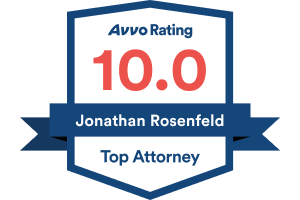- 24/7 Free Consultation: (888) 424-5757 Tap Here To Call Us
How Long Do You Have to File a Workers’ Comp Claim?

Filing a workers’ compensation claim is often an option for employees who suffer injuries or illnesses related to their jobs. Understanding the statute of limitation—the timeframe within which you must submit your claim—is essential in protecting your rights and ensuring you receive the benefits you deserve.
Each state has its own rules regarding this timeline, and if you miss it, you may lose your opportunity for compensation.
Knowing how long you have to file your claim helps ensure that you’re not left without support during your recovery. Having this understanding empowers injured workers by simplifying what can often seem like a complicated process.
If you’ve been injured in a work-related accident, speak with a workers’ compensation attorney from Rosenfeld Injury Lawyers to make sure you get everything you’re entitled to.

Understanding Workers’ Compensation
Workers’ compensation is a form of insurance designed to provide benefits for employees who suffer injuries or illnesses due to work-related activities.
The purpose of workers’ comp is to ensure that injured employees receive necessary medical treatment and compensation for any disabilities resulting from their job injuries. Most jurisdictions require every employer to carry this type of insurance.
If you’re injured at work and must file a claim, you do not have to prove that anyone was negligent or at fault for your injury. In most cases, as long as the injury occurred at work, you can receive these benefits.
Types of Workers’ Compensation Benefits Available
In the event of an injury or occupational disease, there are several types of workers compensation benefits available:
- Medical Benefits: Coverage includes payments for medical bills incurred due to your injury. This can include doctor visits, surgery costs, physical therapy sessions, and any essential medications.
- Income replacement: If you cannot work due to your injury or illness caused by a work accident (including occupational illnesses), you may be eligible for wage-loss benefits. These compensate injured employees while they recover and cannot perform their job duties. Injured employees usually receive a percentage of their wages, somewhere around 66%.
- Disability Benefits: If your condition results in lasting impairment or disability, you may qualify for additional financial support. Disability benefits typically come in two forms: temporary and permanent. Temporary disability benefits assist during recovery if you cannot work for a limited time due to the injury or illness. Permanent disability benefits provide ongoing compensation if your condition results in lasting impairment that affects your ability to work indefinitely.
The Statute of Limitations for Work-Related Injury or Occupational Illness
The statute of limitations in the workers’ compensation process is a critical aspect that every injured employee must understand. This legal timeframe defines how long you have to file a claim after your injury or illness occurs, typically starting from the date of injury or diagnosis for an occupational disease.
Missing this deadline can lead to losing your right to receive workers’ compensation benefits altogether, leaving you without financial support for medical bills and lost wages during recovery.
Employees need to notify their employer immediately and report any incident so they can begin the claims process as soon as possible. Being aware of these time limits allows injured employees to take proactive steps toward securing their rights and ensures they start receiving benefits promptly.
State-Specific Deadlines and Statutes of Limitations
Workers’ compensation statutes of limitations can vary significantly from state to state, making it essential for injured workers to familiarize themselves with the laws specific to their location. Generally, most states allow a claim to be filed within one or two years after the date of injury.
However, some states may have shorter timelines or different deadlines based on various factors, such as whether an occupational disease is involved.
Reporting a work illness or injury to your employer as soon as possible is crucial for many reasons.
First, timely reporting ensures that you receive the appropriate medical treatment and start on the path to recovery. Additionally, notifying your employer immediately helps initiate the workers’ compensation process, which can significantly impact how quickly you begin receiving benefits.
Different states have specific deadlines for reporting workplace injuries or illnesses, typically ranging from 10 to 90 days after the incident occurs. Failing to meet these deadlines may jeopardize your ability to file a successful workers’ comp claim later.
Below is an overview of the standard statute of limitation periods for each state, dictating when workers’ compensation claims must be filed and how long you have to file a lawsuit.
| State | Deadline to Report to Employer | Lawsuit Filing Deadline | Code | Discovery Rule | Exceptions |
|---|---|---|---|---|---|
| Alabama | 5 days | 2 years from the date of injury or 2 years from the date of last compensation payment. | Ala. Code § 25-5-117 | Physical or Mental Incapacity: If an injured employee or their dependent is physically or mentally incapable of taking required action within the specified time, the time limit is extended to two years from when the incapacity ends. | |
| Alaska | 30 days | 2 years from the date of injury or 2 years from the date of last compensation payment. | Alaska Stat. § 23.30.105 | Statute of limitations begins when the employee becomes aware of their disability and its connection to their employment, but no later than 4 years from the date of injury for non-occupational disease claims. | Mentally Incompetent and Minors: If a person entitled to compensation is mentally incompetent or a minor without a guardian, the time limits do not apply until a guardian is appointed, or in the case of a minor, until they reach adulthood if no guardian is appointed beforehand. |
| Arizona | As early as possible | 1 year | Ariz. Rev. Stat. § 23-1061 | The deadline for filing a compensation claim starts when the injury becomes apparent or when the claimant knows, or reasonably should know, that they have sustained a compensable injury. | Material Misrepresentation: The commission or court can consider a late claim if the delay was caused by the employee or claimant reasonably relying on a material representation from the commission, employer, or insurance company. Legally Incompetent: If the employee or claimant is insane, legally incompetent, or incapacitated when the injury happens or during the 1-year period to file a claim, the time limit is paused. If the condition occurs after the one-year period starts, the remaining time is paused until the condition ends. The 1-year period only begins after the incapacity or incompetence ends if it was present at the time of injury. |
| Arkansas | As early as possible | 2 years | Ark. Code § 11-9-702 | Mentall Incompetent and Minors: Statute of limitations does not apply to a mentally incompetent person or minor without a legal guardian, but once a guardian is appointed, or when the minor reaches adulthood, those limitations start to apply. Fraud: If it is proven that an injured employee or their dependents failed to file a claim due to fraud, they have 1 year from discovering the fraud to file the claim. | |
| California | 30 days | 1 year from the date of injury or 1 year from the date of last compensation payment. | Cal. Lab. Code § 5405 | ||
| Colorado | 10 days for maximum compensation; 30 days for occupational diseases | 2 years (3 years with reasonable excuse) to file claim if employer fails to do so | Colo. Rev. Stat. § 8-43-102 | ||
| Connecticut | 1 year from the date of the accident or within 3 years from the first manifestation of a symptom of the occupational disease. | Conn. Gen. Stat. § 31-294c | |||
| Delaware | 90 days | 2 years; 1 year for occupational diseases | Del. Code tit. 19 § 2361 | For occupational diseases, statute of limitations starts when the employee first becomes aware, or reasonably should have known, that their disability was or could have been caused by their employment. | |
| Florida | 30 days | 2 years | Fla. Stat. § 440.19 | Statute of limitations starts from when the employee knew or should have known that the injury or death arose out of work performed in the course and scope of employment | Minors and Mentally Incompetent: If a person entitled to compensation is mentally incompetent or a minor without a guardian, the limitations period is paused, but it begins running once a guardian is appointed or, in the case of a minor, when the person reaches adulthood if no guardian is appointed. |
| Georgia | 30 days | 1 year after date of injury, 1 year after the date of the last remedial treatment furnished by the employer, or within 2 years after the date of the last payment of weekly benefits. | Ga. Code § 34-9-82 | ||
| Hawaii | as immediately as practicable | 2 years after disability begins and 5 years from the date of the accident in most cases | Haw. Rev. Stat. § 386-82 | Certain Hazardous Substances: The time limits do not apply to claims for injuries caused by exposure to hazardous substances – like asbestos, radiation, and other substances with carcinogenic properties – but such claims must be filed in writing within 2 years of knowing the injury was caused by the employment. | |
| Idaho | 60 days | 1 year | Idaho Code § 72-701 | ||
| Illinois | 45 days | 3 years from the date of the accident or 2 years after the date of the last payment of compensation | 820 ILCS 305/6 | Asbestos and Other Dangerous Materials: For injuries caused by exposure to radiological materials or asbestos, a compensation claim must be filed within 25 years of the employee’s last day working in a hazardous environment. | |
| Indiana | 30 days | 2 years from the date of the accident or 2 years from the date of the last payment | Ind. Code § 22-3-3-3 | Radiation Exposure: In cases of injury or death caused by radiation exposure, a compensation claim must be filed within 2 years from the date the employee became aware, or should have reasonably known, of the injury and its connection to their employment. | |
| Iowa | 90 days | 2 years from accident or 3 years from date of last payment | Iowa Code Section 85.26 | Statute of limitations starts on the date that the employee knew or should have known that the injury was work-related | |
| Kansas | 20 days | 3 years from the accident or 2 years from the date of the last payment, whichever is later. | Kan. Stat. § 44-534 | ||
| Kentucky | as soon as practical | 2 years | Ky. Rev. Stat. § 342.185 | HIV: Claims for exposure to HIV must be filed within 5 years of the exposure. Cumulative Trauma: Within 2 years of a physician informing the employee that the injury is work-related and within 5 years of the employee’s last exposure to the cumulative trauma. | |
| Louisiana | 30 days | 1 year from the injury or from when the injury develops | La. Stat. tit. 23 § 1209 | ||
| Maine | 60 days | 1 year | Me. Stat. tit. 39-A § 905 | ||
| Maryland | 60 days | 1 year for occupational diseases; 2 years for accidental injuries | Md. Code, Lab. & Empl. § 9-705/Md. Code, Lab. & Empl. § 9-709 | Discovery rule exists for occupational injury claims – statute of limitations starts from the date the employee knew or should have known. | |
| Massachusetts | as soon as practicable | 4 years | Mass. Gen. Laws ch. 152 § 41 | Statute of limitations begins on the date the employee first became aware of the causal relationship between his disability and his employment | |
| Michigan | 90 days | 2 years | Mich. Comp. Laws § 418.381 | Physically or Mentally Incapacitated: If the employee is physically or mentally incapacitated, the notice and claim must be filed within 2 years from the time the employee is no longer incapacitated and able to make the claim. | |
| Minnesota | 14 days | 3 years after the written report of the accident and no more than 6 years from the date of the accident | Minn. Stat. § 176.151 | Discovery rule exists for ior injuries caused by x-rays, radiation, or occupational diseases – statute of limitations begins when the employee knows the cause of the injury and the injury resulting in disability. | Physical or Mental Incapacity: If the injured person or their dependents are physically or mentally incapacitated (NOT including minors), the time limit for taking required action is extended for 3 years from the date the incapacity ends. |
| Mississippi | 30 days | 2 years | Miss. Code § 71-3-35 | Mentally Incompetent or Minor: If a person entitled to compensation is mentally incompetent or a minor without a guardian, the time limit for filing benefits does not apply until a guardian is appointed or, in the case of a minor, when the individual reaches adulthood if no guardian is appointed beforehand. | |
| Missouri | 30 days | 2 years | Mo. Rev. Stat. § 287.430 | ||
| Montana | 30 days | 1 year | Mont. Code § 39-71-601 | The insurer can extend the time limit by up to 24 months if the claimant reasonably demonstrates a lack of knowledge of the disability, a latent injury, or equitable estoppel. For occupational diseases, statute of limitations begins when the employee knew or should have known about their condition and that it resulted from their an occupational disease. | |
| Nebraska | as soon as practicable | 2 years | Nebraska Rev. Stat. § 48-137 | Legal Disability: If an injured employee or their dependent has a legal disability, the limitation shall not take affect until the expiration of 2 years from the time of the removal of the legal disability. | |
| Nevada | 7 days | 90 days from the date the incident occurs or from the date a person receives a diagnosis of an occupational disease or illness | Nevada Rev. Stat. § 616C.020 | ||
| New Hampshire | 2 years | 3 years | N.H. Rev. Stat. § 281-A:21-a | Statute of limitations begins on date the employee knows, or by reasonable diligence should know, of the nature of the injury and its possible relationship to the employment | |
| New Jersey | 14 days | 2 years | N.J. Stat. § 34:15-51 | ||
| New Mexico | 15 days | 1 year | N.M. Stat. § 52-1-31 | ||
| New York | 30 days | 2 years | N.Y. Workers’ Comp. Law § 28 | Occupation disease – statute of limitations begins when the employee knew or should have known that the disease is or was due to the nature of the employment. | |
| North Carolina | 30 days | 2 years | N.C. Gen. Stat. § 97-24 | For occupational diseases, the timeline runs from the date the employee has been advised by competent medical authority that he has an occupational disease. | |
| North Dakota | 7 days | 1 year | N.D. Cent. Code § 65-05-01 | Statute of limitations runs from the first date that a reasonable person knew or should have known that the employee suffered a work-related injury and has either lost wages because of a resulting disability or received medical treatment | |
| Ohio | 1 year for accidents, 2 years for occupational diseases | Ohio Rev. Code § 4123.84 | |||
| Oklahoma | 30 days | 2 years for accidents, 1 year for occupational diseases | Okla. Stat. tit. 85A § 69 | Incompetent or Minor: The time limitations do not apply to a mentally incompetent person or minor without a guardian, but they begin to apply from the date a guardian is appointed, or, if no guardian is appointed, when the minor reaches the age of majority. Asbestosis: A claim for compensation due to disability from silicosis or asbestosis must be filed within 1 year of the disablement, and the disablement must occur within 3 years of the last harmful exposure to the hazard. | |
| Oregon | as soon as possible | 2 years | ORS § 656.019 | ||
| Pennsylvania | 21 days | 3 years | 77 Pa. Stat. § 602 | In cases of injury from ionizing radiation, the time for filing a claim begins only when the employee knows, or should reasonably know through diligence, about the injury and its possible connection to their employment. | |
| Rhode Island | 30 days | 2 years | R.I. Gen. Laws § 28-35-57 | Statute of limitations ccurs after the occurrence or manifestation of the injury or incapacity; For latent or undiscovered impairment, the clock starts when the person knew or should have known about the impairment and its link to employment, or after disablement, whichever is later. | Physical or Mental Incapacity: Statute of limitations is 2 years from the removal of the physical or mental incapacity. |
| South Carolina | 90 days | 2 years | S.C. Code § 42-15-40 | Statute of limitations for occupational diseases begins when the employee has been diagnosed definitively as having an occupational disease and has been notified of the diagnosis; For a repetitive trauma injury, the right to compensation is barred unless a claim is filed within 2 years of the employee knowing or reasonably should have known the injury is compensable, but no later than 7 years after the last injurious exposure. | |
| South Dakota | 3 days | 2 years | S.D. Codified Laws § 62-7-35 | ||
| Tennessee | 15 days | 1 year | Tenn. Code § 50-6-203 | ||
| Texas | 30 days | 1 year | Tex. Lab. Code § 409.003 | For occupational injuries, the statute of limitations begins when the employee knew or should have known that the disease was related to the employee’s employment. | |
| Utah | 180 days | 1 year | Utah Code § 34A-2-417 | Deadling begins on the day on which the employee knows or in the exercise of reasonable diligence should have known that the medical expense is related to the industrial accident | |
| Vermont | as soon as practicable | 6 months | Vt. Stat. tit. 21 § 656 | The deadline starts from the point in time when the injury or disease, and its relationship to the employment is reasonably discoverable and apparent | |
| Virginia | 30 days | 2 years | Va. Code § 65.2-601 | ||
| Washington | as soon as possible | 1 year for accidents, 2 years for occupational diseases | Wash. Rev. Code § 51.28.025 | ||
| Washington, D.C. | 30 days | 1 year | D.C. Code § 32-1514 | Statute of limitations runs when the employee or beneficiary is aware, or by the exercise of reasonable diligence should have been aware, of the relationship between the injury or death and employment. | Mentally Incompetent or Minor: If a person entitled to compensation is mentally incompetent or a minor without a guardian, the time limits do not apply, but they start from the date a guardian is appointed or, in the case of a minor, when the person reaches adulthood if no guardian is appointed. |
| West Virginia | 6 months | Occupational Pneumoconiosis: 3 years of the last continuous 60-day period of exposure to the hazard, or within three years of when a physician informed the employee of the diagnosed impairment. Other Occupational Diseases: For other occupational diseases, a claim must be filed within three years of the employee’s last exposure to the occupational hazard or within three years of when the employee was informed of the disease by a physician or reasonably should have known about it. | |||
| Wisconsin | 30 days | 12 years for occupational diseases; 6 years for traumatic injuries | Wis. Stat. § 102.17 | Minors: If an employee or dependent is under 18 at the time of injury or when their right to compensation arises, the time limit for filing a claim is extended to 1 year after they turn 18, if it would have otherwise expired sooner. Insane or Active Duty: If an employee, their representative, or surviving dependent is insane or on active duty in the U.S. armed forces during the last year of the limitation period, the time limit is extended by 2 years from the original expiration date. | |
| Wyoming | 72 hours | 1 year | Wyo. Stat. § 27-14-503 | For injuries not readily apparent, the statute of limitations is within 1 year after discovery of the injury by the employee. | Injuries That Develop Over Time: Claims for an injury that develops over time must be filed within 1 year of the diagnosis being communicated to the employee, or within 3 years of the last harmful workplace exposure, whichever is later. |
Filing a Workers’ Comp Claim
After reporting a workplace injury or illness to your employer, the next step is filing a claim for workers’ comp benefits. Below are the steps involved in this process:
- Complete Required Documentation: Gather any documents related to your job injury, including medical records, witness statements, and incident reports.
- File Your Claim: Most states allow you between one and three years after the date of injury or diagnosis for an occupational disease to file a workers comp claim with their insurance. Check your state’s specific timeframe, as it will influence how quickly you must act. It’s also important to note that in some cases, the time limit may not begin until you’ve received your last payment for medical care or disability.
- Submit Your Claim: Once all necessary documentation is compiled and completed, submit your claim to the appropriate workers’ compensation board or insurance carrier. Ensure that you keep copies of everything submitted for your records.
If you have experienced a work-related illness or injury and need assistance navigating the claims process, do not hesitate to reach out to an experienced law firm.
Special Considerations
In certain situations, the time limit for filing for workers’ compensation may be extended. Understanding these exceptions is important, especially for those dealing with occupational diseases or cumulative trauma injuries.
- Occupational Disease: If your injury stems from an occupational disease – conditions like long-term exposure to harmful substances – this is one exception where the date of injury might not be clear-cut. The statute of limitations may begin from the date you received a medical diagnosis rather than when symptoms first appeared.
- Cumulative Trauma: Cumulative trauma results from repeated strains over time rather than one specific incident. For example, if you’re an employee who develops carpal tunnel syndrome due to repetitive work tasks over several months or years, you may have more flexibility regarding when you can file your claim.
Injurious Exposure
The concept of “injurious exposure” is also important to understand in these situations. This concept applies when a worker becomes disabled due to injuries or conditions suffered while working for successive employers.
Under the injurious exposure rule, liability for workers’ compensation benefits is typically placed on the last employer at which the condition was aggravated or where the employee experienced significant exposure to harmful substances.
Understanding how injurious exposure impacts your ability to obtain benefits is essential in ensuring you pursue adequate compensation from the appropriate party. For any questions related to a work injury, contact Rosenfeld Injury Lawyers today.
Third-Party Involvement
When employees suffer an injury due to their employment, they typically rely on workers’ compensation to cover medical expenses and lost wages. However, if a third party is involved—such as another company, a defective product, or exposure to hazardous substances—the injured worker may have the option to file a personal injury lawsuit against a person or company in addition to their workers’ comp claim.
Damages in a Personal Injury Lawsuit
In a personal injury lawsuit, you can pursue compensation beyond what workers’ compensation covers. For example, you may seek damages for pain and suffering, which is not included in typical workers’ compensation benefits. The statute of limitations for this type of lawsuit differs from the deadline for your workers’ comp claim.
Navigating these claims can be complex, so consulting with a personal injury attorney is recommended to explore your options. They can provide guidance on reporting the injury, determining the last date you were hurt, and understanding how much time you have to file a claim.
Additionally, an attorney can help you understand the role of the insurance company and what payments you might be eligible to receive. They will help you file a lawsuit if appropriate.
Your Next Steps

Navigating the workers’ compensation claim process can be challenging, as you’re dealing with strict deadlines and legal nuances. Seeking assistance from an experienced workers’ compensation attorney can make a significant difference in your case.
The team at Rosenfeld Injury Lawyers understands the importance of timely reporting and will make sure you file a claim before the last date allowed by law to avoid losing your benefits. An attorney from our law firm can help you navigate the complicated regulations, compile necessary documentation for claims, and represent you during negotiations with insurance companies.
Call (888) 424-5757 or complete our online contact form.
All content undergoes thorough legal review by experienced attorneys, including Jonathan Rosenfeld. With 25 years of experience in personal injury law and over 100 years of combined legal expertise within our team, we ensure that every article is legally accurate, compliant, and reflects current legal standards.







